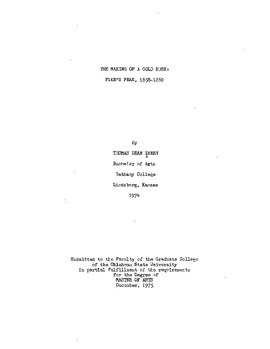| dc.description.abstract | In the spring of 1859 the Rocky Mountains awoke to the touch of someone tickling their feet. Throwing off their white sheets, they yawned eastward and spied a surging line of men stretching far away toward the Missouri River, resembling nothing so much as a great ant anny. At the toes of the mountains the men-ants fanned noisy clusters, then dispersed to climb into the mountains themselves, only to be replaced by new clusters. Never had the Rockies seen men of such an obnoxious breed. Trappers and traders, Indians, explorers, conquering armies and passing tides of emigration had entered the mountains before, but then had gone and left them in peace. But the newcomers tore up the ground like so many badgers; they felled the timber, erected cabins and gave every indication that they would stay indefinitely. The slumber of the Rockies was forever over. The great Pike's Peak gold rush had planted a new commonwealth upon them. The gold rush itself was an event of sensational color, full of tragedy and triumph. It was wagons, windwagons, wheelbarrows, handcarts, pedestrians and even dogsleds crossing the plains. It was conniving politicians and speculators. It was fortunes for some men and subsistence on prickly pears for others. It was tens of thousands of personal vignettes, each one a dramatic tale. But it was more than just a great story. It was an event of enduring importance and profound, but ambiguous meaning. This thesis is a study of the causes of the gold rush, which were much more than a flash of yellow in a prospector's pan, and the resulting nature of the gold rush emigration. When illuminated the causes of the gold rush put its importance into clear focus. An introductory chapter briefly relates the story of the gold rush in a nonanalytical way. Ensuing chapters then proceed in problem-solving fashion to determine the motives of its participants. A concluding chapter points out that the nature of the gold rush emigration, determined by its causes, had important implications both for the nineteenth century and for modern historiography. | |
